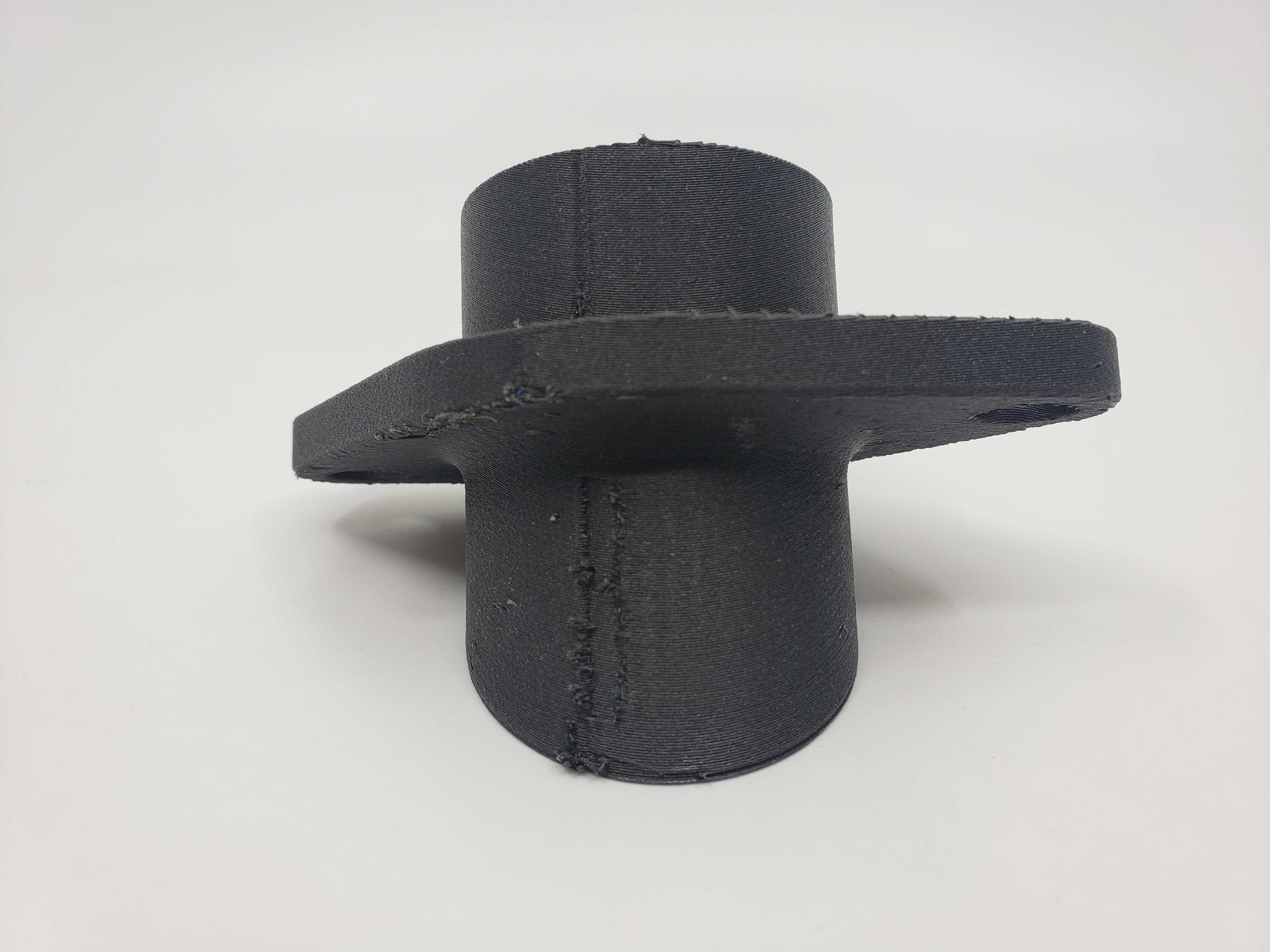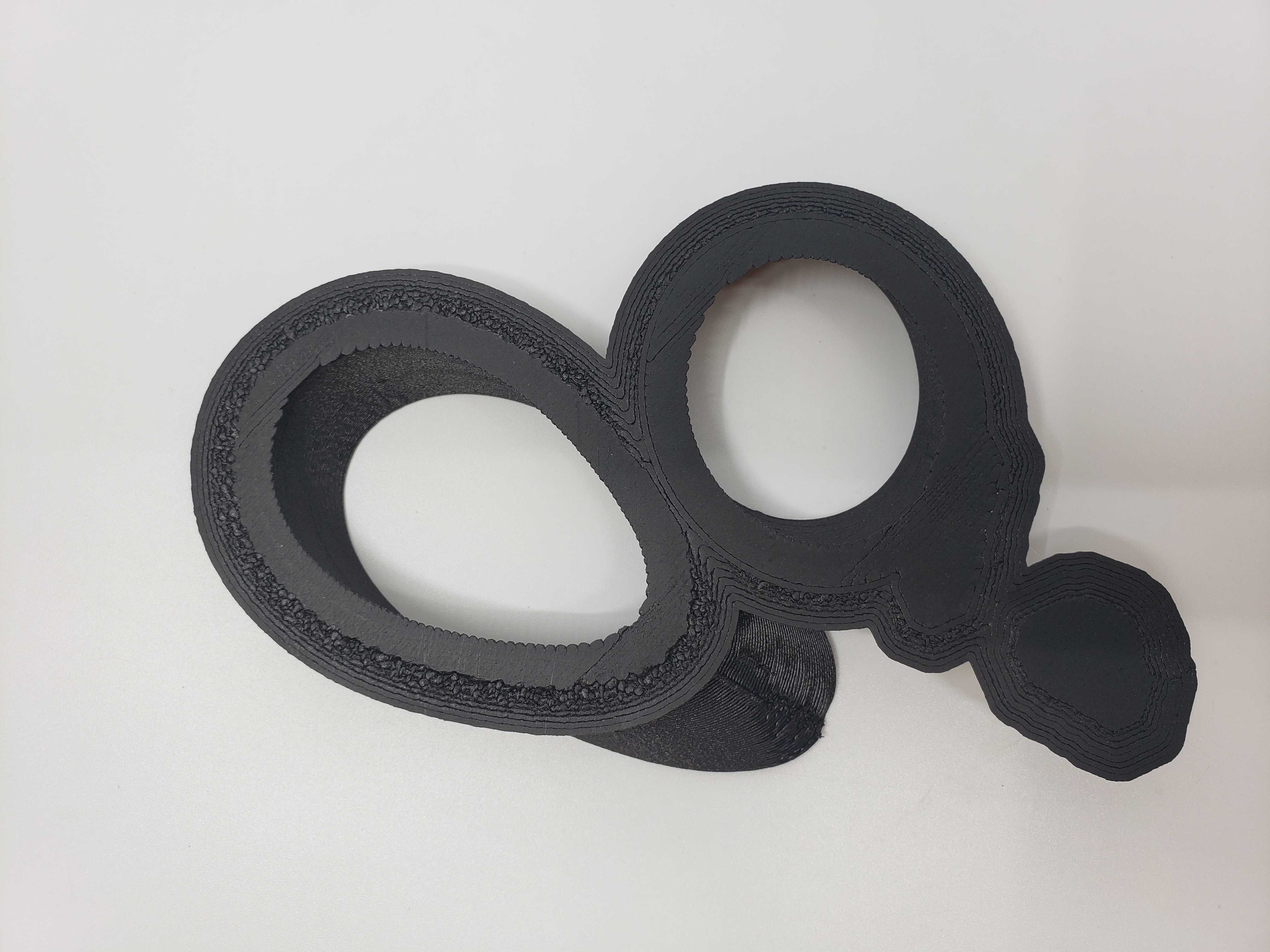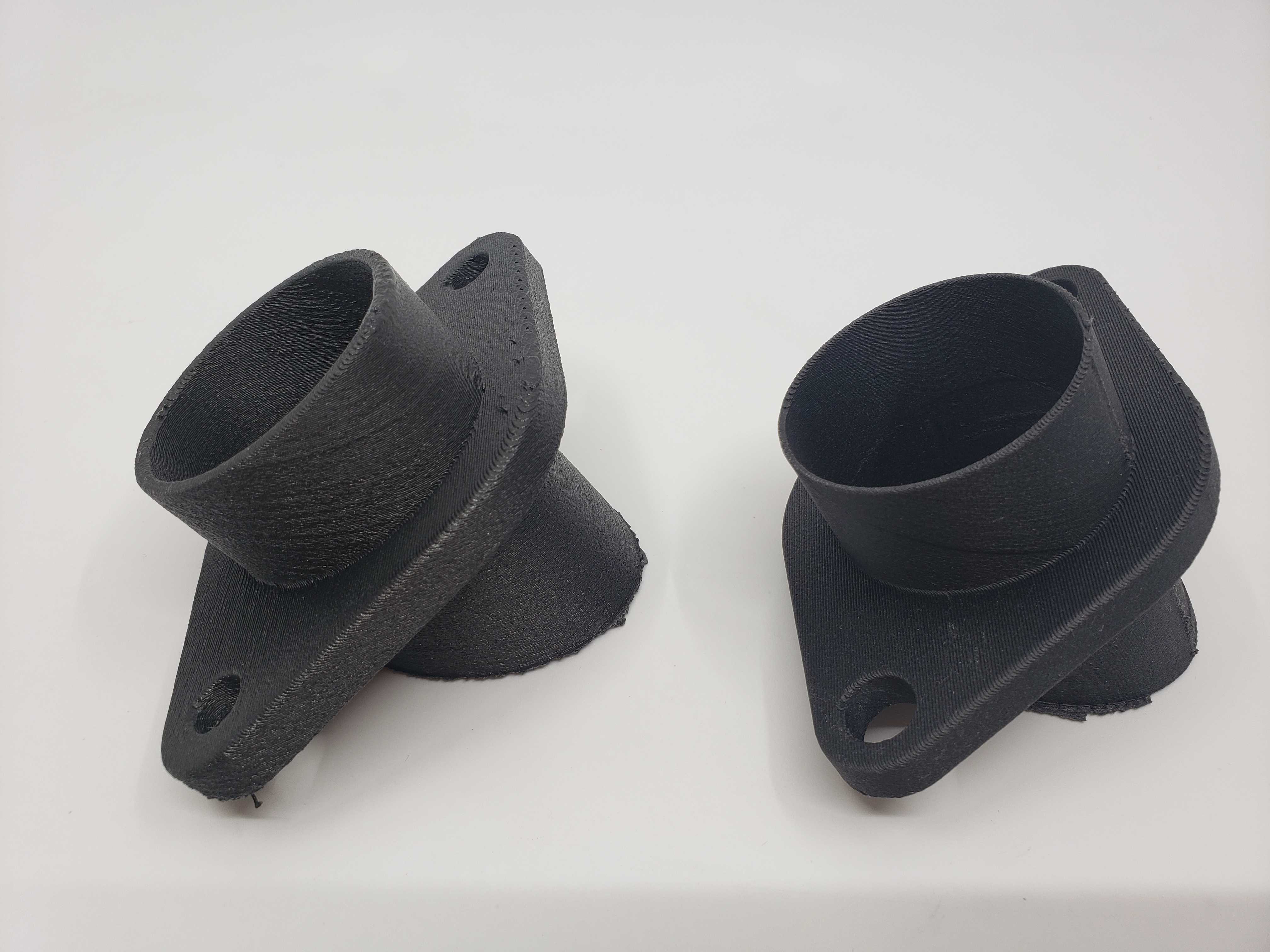DSM Novamid® ID1030 CF10 PA6/66
DSM Novamid® ID1030 CF10 is a semi-crystalline carbon fiber-filled polyamide filament used for durable structural parts with high dimensional stability that are stronger, stiffer, and tougher. With a carbon fiber loading of just 10%, Novamid® ID1030 CF10 prints parts with properties close to what is usually achievable only by injection molding.
Due to its excellent mechanical properties and smooth surface quality, it is well-suited for demanding automotive structural applications that require robust performance at elevated temperatures.
Printing Difficulty: Intermediate
Novamid® ID1030 CF10 PA6/66 can be purchased from AON3D directly by contacting help@aon3d.com.
- Moisture Control
- Build Platform Adhesion
- General Process Settings
- Post-Processing
- Technical Specifications
- Troubleshooting
Moisture Control
Novamid® ID1030 CF10 is extremely susceptible to moisture uptake. Oozing with a rough and less matte surface finish may occur if it has been hydrated, see the Rough and Shiny Surface Finish section for more information.
The filament can be dried in a convection oven at 80ºC for at least 4 hours before processing and fed from a low humidity environment.
Make sure the spool is not deforming due to the temperature.
When not in use, store in a sealed package or container with silica desiccant to inhibit moisture absorption.
Our filament dry storage and feed system setup prevents filament moisture uptake to keep the material printing process free of moisture, contact help@aon3d.com for more information.
For more information, see the Filament Drying and Moisture Control guide.
Build Platform Adhesion
For instructions on how to inspect the AON3D build plates, refer to the Inspect and Clean Build Plates procedure.
Garolite G-10 Build Sheet
Novamid® ID1030 CF10 prints best on the Garolite G-10 build sheet due to strong adhesion behavior while at recommended bed temperatures and clean removal once the build sheet is cooled down. The G-10 surface is sensitive to Z offset calibration and scratches or scuffs on the surface. For the best results, use a lower first layer speed, a higher first layer extrusion temperature, and remove the parts gently after prints are complete to minimize damage on the build surface.
PEI Build Sheet
Novamid® ID1030 CF10 prints with limited adhesion on the PEI build sheet with the use of a wide brim. Wipe down the PEI build sheet with isopropanol before use.
The PEI build sheet is sensitive to Z offset calibration. Ensure that the machine has reached thermal equilibrium before calibrating. If the bed-to-nozzle distance is too close, excessive material accumulation on the PEI build sheet may occur.
For more information, see the First Layer Distance Too Close section.
CF-PEEK Composite Plate With Nano Polymer Adhesive
Novamid® ID1030 CF10 prints with limited adhesion on the CF-PEEK composite plate with the use of Nano Polymer Adhesive, an applied adhesion aid. The Nano Polymer Adhesive may improve adhesion first layer adhesion when the bed temperature is set at most to 100ºC.
First Layer Adhesion
Do not use bed temperatures above 85ºC for both build-platform options. Bed temperatures too high may cause the first few layers to crystalize enough to cause part warping.
First layer adhesion can be improved by increasing the Extrusion Temperature or reducing First Layer Speed. First Layer Height and First Layer Width with a value of 100-150% for both is generally sufficient for Novamid® ID1030 CF10. Reduce first layer adhesion if you have trouble removing the part and/or you damage the build platform during part removal.
| First Layer Extrusion Temperature | First Layer Speed |
|---|---|
| 270-280ºC | 30-50 mm/s |
For more information, see the Build Platform Adhesion guide.
High-Temperature Build Plate
Novamid® ID1030 CF10 prints best on the High-Temperature Build Plate
Warping is generally not an issue due to its low thermal shrinkage. In general, a part may shrink a value of 1.01 (1%) from its desired dimension depending on the printing conditions. However, bed temperatures too high still may cause the first layer to slightly shrink and warp due to its crystallization behaviors.
First Layer Adhesion
First layer adhesion can be improved by increasing the Extrusion Temperature or reducing First Layer Speed. First Layer Height and First Layer Width with a value of 100-150% for both is generally sufficient for Novamid® ID1030 CF10. Reduce first layer adhesion if you have trouble removing the part and/or you damage the build platform during part removal.
| First Layer Extrusion Temperature | First Layer Speed |
|---|---|
| 270-280ºC | 30-50 mm/s |
For more information, see the Build Platform Adhesion guide.
High-Temperature Build Plate
Novamid® ID1030 CF10 prints best on the High-Temperature Build Plate
Warping is generally not an issue due to its low thermal shrinkage. In general, a part may shrink a value of 1.01 (1%) of its desired dimension depending on the printing conditions. However, bed temperatures too high still may cause the first layer to slightly shrink and warp due to its crystallization behaviors.
First Layer Adhesion
First layer adhesion can be improved by increasing the Extrusion Temperature or reducing First Layer Speed. First Layer Height and First Layer Width with a value of 100-150% for both is generally sufficient for Novamid® ID1030 CF10. Reduce first layer adhesion if you have trouble removing the part and/or you damage the build platform during part removal.
| First Layer Extrusion Temperature | First Layer Speed |
|---|---|
| 270-280ºC | 30-50 mm/s |
For more information, see the Build Platform Adhesion guide.
General Process Settings
For best results, process settings should be adjusted based on model geometry. If you require process development support, our Applications Engineering team can help! Send us a message at help@aon3d.com to consult with one of our Additive Manufacturing Specialists.
Optimal extrusions are visually black with a rough texture. Novamid® ID1030 CF10 requires the use of at least a 0.40mm and wear-resistant nozzles such as hardened steel or tungsten-carbide coated steel due to its abrasive nature. It can be printed at the same speeds as un-reinforced plastics (30-80 mm/s) while achieving better strength and toughness due to the 10% carbon fiber reinforcement.
Small, low-mass, and larger parts can be printed at moderate extrusion temperatures without much difficulty as the degree of crystallization-induced shrinkage is low. Part warping and deformation are generally not an issue due to the 10% carbon fiber reinforcement. However, avoid very high extrusion temperatures as it may induce enough polymer shrinkage from crystallization to cause part warping.
| Setting | AON M2+ | AON-M2 2020 | AON-M2 |
|---|---|---|---|
| Extrusion Temperature | 260-285ºC | 260-285ºC | 260-285ºC |
| Bed Temperature | 85ºC | 115ºC | 115ºC |
| Chamber Temperature | 80ºC | 80ºC | 80ºC |
| Print Speed | 30-80 mm/s | 30-80 mm/s | 30-80 mm/s |
| Nozzle Size | 0.40-1.00 mm | 0.40-1.00 mm | 0.40-1.00 mm |
| Preferred Build Platform | Garolite G-10 Build Sheet | High-Temperature Build Plate | High-Temperature Build Plate |
Composite material filaments are abrasive.
AON3D recommends using a heater block assembly equipped with a tungsten carbide nozzle to improve surface finish and reduce nozzle wear.
Contact the Customer Success team at help@aon3d.com to order the assembly.
Dual Extrusion and Support
AquaSys® 120 is compatible as a dissolvable support material for Novamid® ID1030 CF10. To ensure build platform compatibility between Novamid® ID1030 CF10 and AquaSys® 120, we recommend using the PEI build sheet rather than the CF-PEEK composite plate for improved first layer adhesion. Dual tool printing with Novamid® ID1030 CF10 and AquaSys® 120 requires fine-tuning for optimal printing. For more information about printing with this support material, see the AquaSys® 120 guide.
Novamid® ID1030 CF10 tends to ooze a lot while in idle. As shown in the figure below, the start of the perimeter while printing outside-in initially under-extrudes due to the loss of material and pressure.

Increasing the Retraction Distance and Extra Restart Distance in Tool Change Retraction may mitigate the loss of material and pressure that may cause under extrusion at the beginning of each layer. If the geometry permits, printing inside-out may be an option to hide the under-extruded seam without drastically modifying the Tool Change Retraction settings.
Adding a wipe in the Tool Change Script will clean the tool head as it oozes and purges between each layer. The extrusion temperature of Novamid® ID1030 CF10 can be decreased during idle to 240ºC if needed. Though, it is not usually necessary as Novamid® ID1030 CF10 is resilient enough to not degrade within its processing temperatures for moderate periods.
For more information, see the Using Supports and Support Materials and Dual Extrusion page.
Sample Slicer Profile
SuperSlicer
All AON3D-validated materials are available in the SuperSlicer configuration bundle. Refer to SuperSlicer Installation and Update to install and update the SuperSlicer software. Follow the instructions to update to the latest version to ensure you have access to all available materials.
Simplify3D®
Simplify3D® sample profiles for Novamid® ID1030 CF10 are available in the Downloadable Assets section.
Post-Processing
Allow all machine components to reach room temperature before proceeding further. Failure to allow components to cool down will result in thermal injury (burns) to personnel.
Garolite G-10 Build Sheet
Novamid® ID1030 CF10 parts separate easily from the Garolite G-10 build sheet by hand at room temperature. If needed, a spatula can facilitate part removal.
PEI Build Sheet
Novamid® ID1030 CF10 parts can be peeled off the PEI build sheet by hand at room temperature. If needed, a spatula can facilitate part removal.
CF-PEEK Composite Plate With Nano Polymer Adhesive
Novamid® ID1030 CF10 parts separate easily from the CF-PEEK composite plate with Nano Polymer Adhesive by hand at room temperature. If needed, a spatula can facilitate part removal.
High-Temperature Build Plate
Novamid® ID1030 CF10 parts may easily separate from the High-Temperature Build Plate given a sudden impact. The use of a spatula can facilitate part removal if needed.
High-Temperature Build Plate
Novamid® ID1030 CF10 parts may easily separate from the High-Temperature Build Plate given a sudden impact. The use of a spatula can facilitate part removal if needed.
Shrinkage, deformation, and warpage due to thermal shock may occur from removing the part before letting the machine cool. Instructions for removing the part from the build platform and additional support material can be found on the Build Platform Adhesion and Using Supports and Support Materials guides.
Technical Specifications
For more information on material safety and specific material properties, see the manufacturer’s website.
Physical Properties
| Property | Value | Test Method |
|---|---|---|
| Density | 1.17g/cm³ | ISO 1183 |
| Melting Temperature (10 ºC/min) | 200ºC | ISO 11357-1/-3 |
| Glass Transition Temperature (10 ºC/min) | 58ºC | ISO 11357-1/-2 |
*All data as reported by DSM Technical Data Sheet as downloaded on 10/6/2020. Print conditions listed on the Technical Data Sheet.
Troubleshooting
Nozzle Clogging
Clogging may occur frequently when using a 0.4mm nozzle or lower. We recommend opting for a bigger nozzle to print Novamid® ID1030 CF10 to avoid nozzle clogging. Clogging may occur during your first layer if the nozzle is too close to the bed. If it occurs, make sure to redo your Z calibration, and change the offset if necessary.
First Layer Distance Too Close
Novamid® ID1030 CF10 is sensitive to bed-to-nozzle distance. If the nozzle-to-bed distance is too small, the material may not adhere to the bed properly and can curl upwards. An over-extrusion effect will appear, causing the material to accumulate on the side of the nozzle and its path instead of being extruded and compressed onto the build platform. Visually, the underside of the part may show extrusions that are not uniform in shape (bubbles) and size with extreme overlapping of brims and/or perimeters as shown in the figure below.
This effect may also occur when using the PEI build sheet. Shrinkage induced by polymer crystallization may cause your first layer to warp. Not only the nozzle-to-bed distance must be adjusted perfectly, but the bed temperature also must not be too high.
Perform the Z Offset Calibration and adjust the Z offset until consistent extrusions with minimally overlapping are achieved.

Rough and Shiny Surface Finish
Drying of Novamid® ID1030 CF10 is critical for optimal printing performance, but maintaining dryness is also difficult. Hydrated filament may produce an undesired roughness to the surface that is shiny instead of matte as shown in the figure below. The left part has been printed with hydrated filament, resulting in a rough and shiny surface quality compared to the right part that was sufficiently dried.
Follow the drying procedure in the above Moisture Control section.

Excessive Oozing
Novamid® ID1030 CF10 is susceptible to oozing even when properly dried and fed from a low humidity environment. Excessive oozing may occur, especially during retraction movements and tool change idling, when the filament has been hydrated.
Follow the drying procedure in the above Moisture Control section.